Abstract
The concept of conditioned reinforcement has received decreased attention in learning textbooks over the past decade, in part because of criticisms of its validity by major behavior theorists and in part because its explanatory function in a variety of different conditioning procedures has become uncertain. Critical data from the major procedures that have been used to investigate the concept (second-order schedules, chain schedules, concurrent chains, observing responses, delay-of-reinforcement procedures) are reviewed, along with the major issues of interpretation. Although the role played by conditioned reinforcement in some procedures remains unresolved, the results taken together leave little doubt that the underlying idea of conditioned value is a critical component of behavior theory that is necessary to explain many different types of data. Other processes (marking, bridging) may also operate to produce effects similar to those of conditioned reinforcement, but these clearly cannot explain the full domain of experimental effects ascribed to conditioned reinforcement and should be regarded as complements to the concept rather than theoretical competitors. Examples of practical and theoretical applications of the concept of conditioned reinforcement are also considered.
Keywords: conditioned reinforcement, behavior theory, observing behavior, chain schedules, delay of reinforcement, concurrent chains
Full text
PDF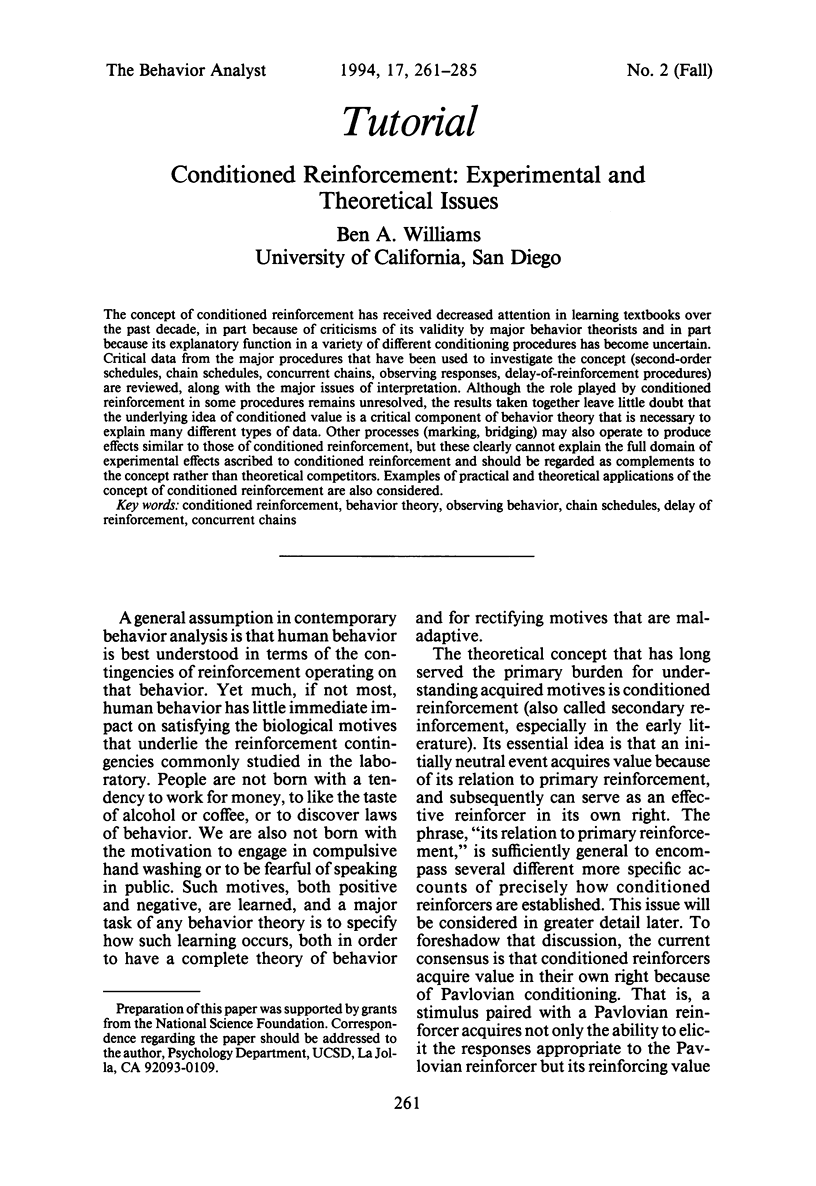
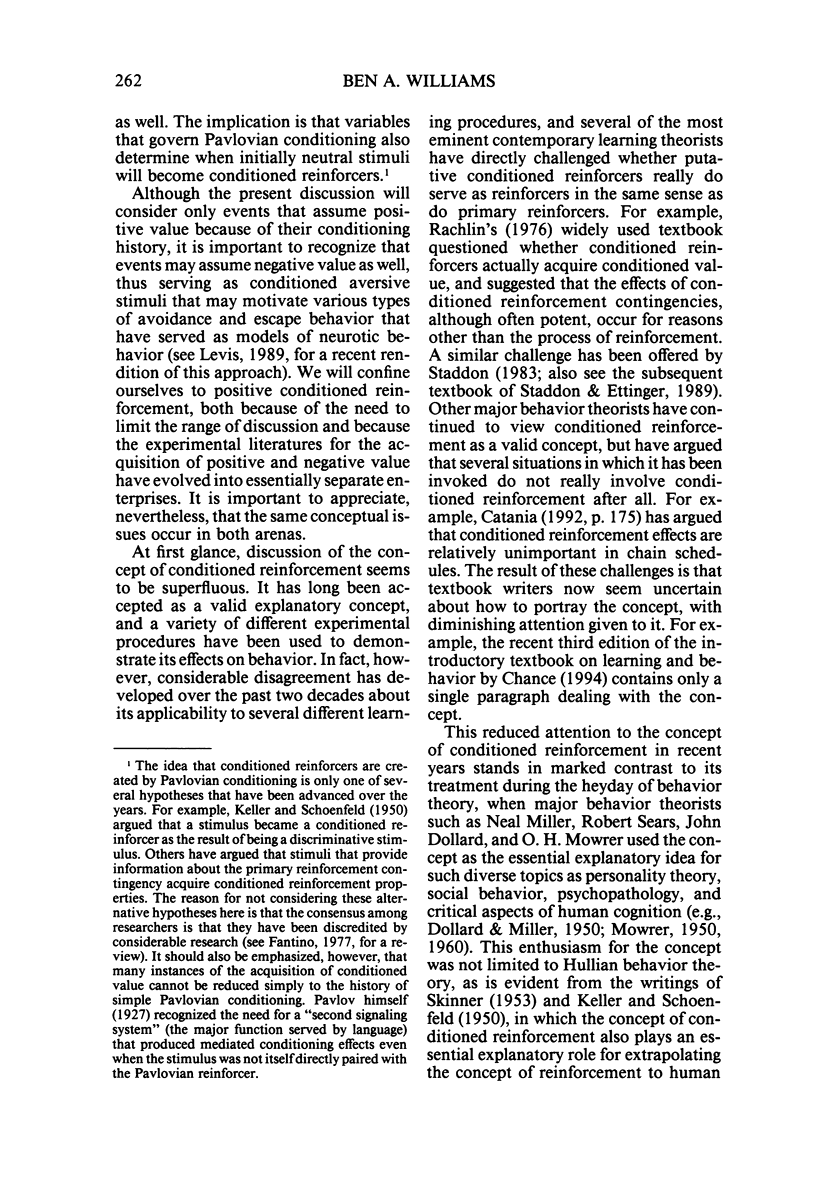

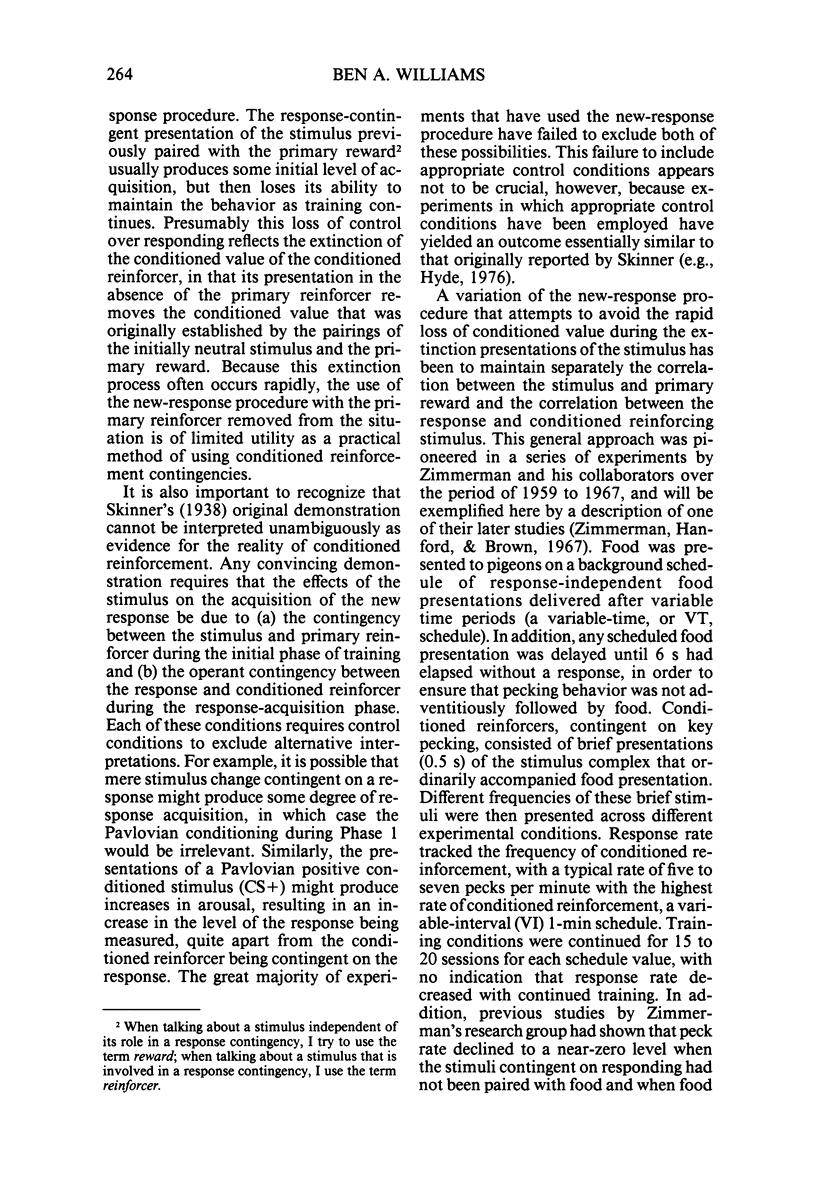
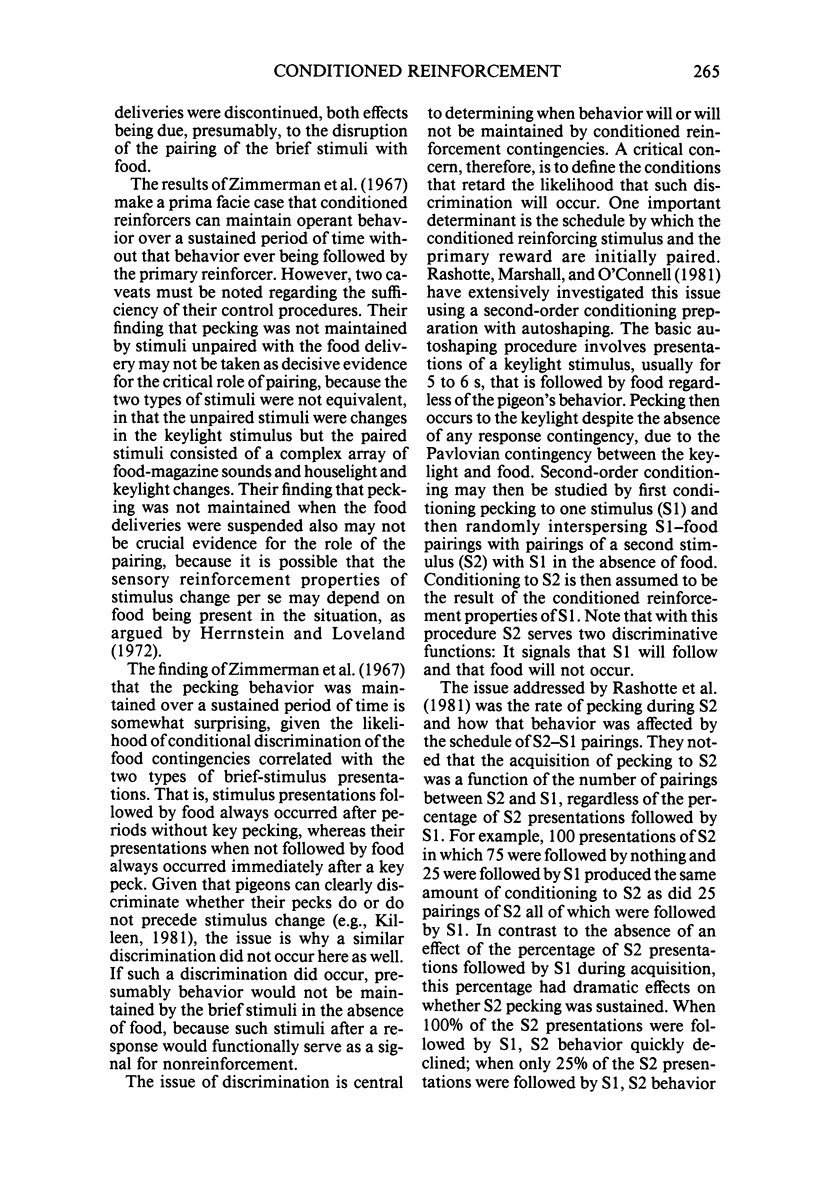
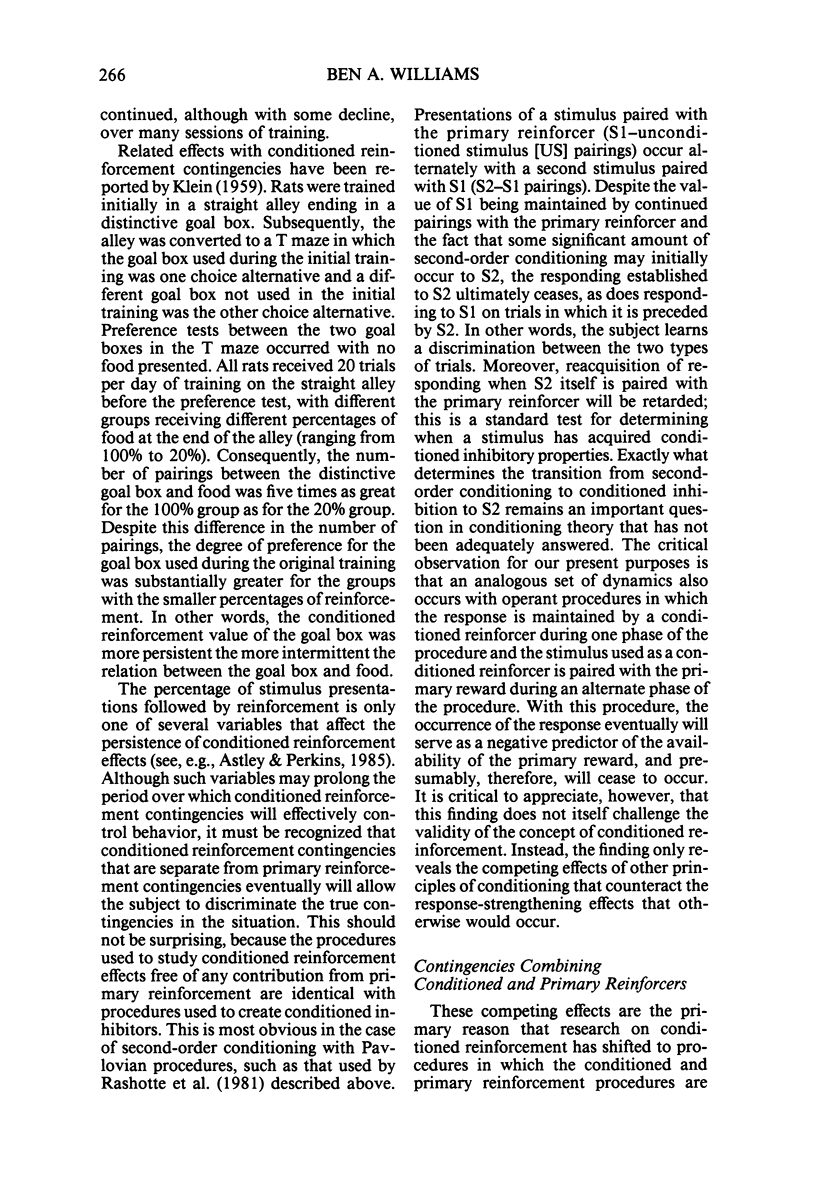
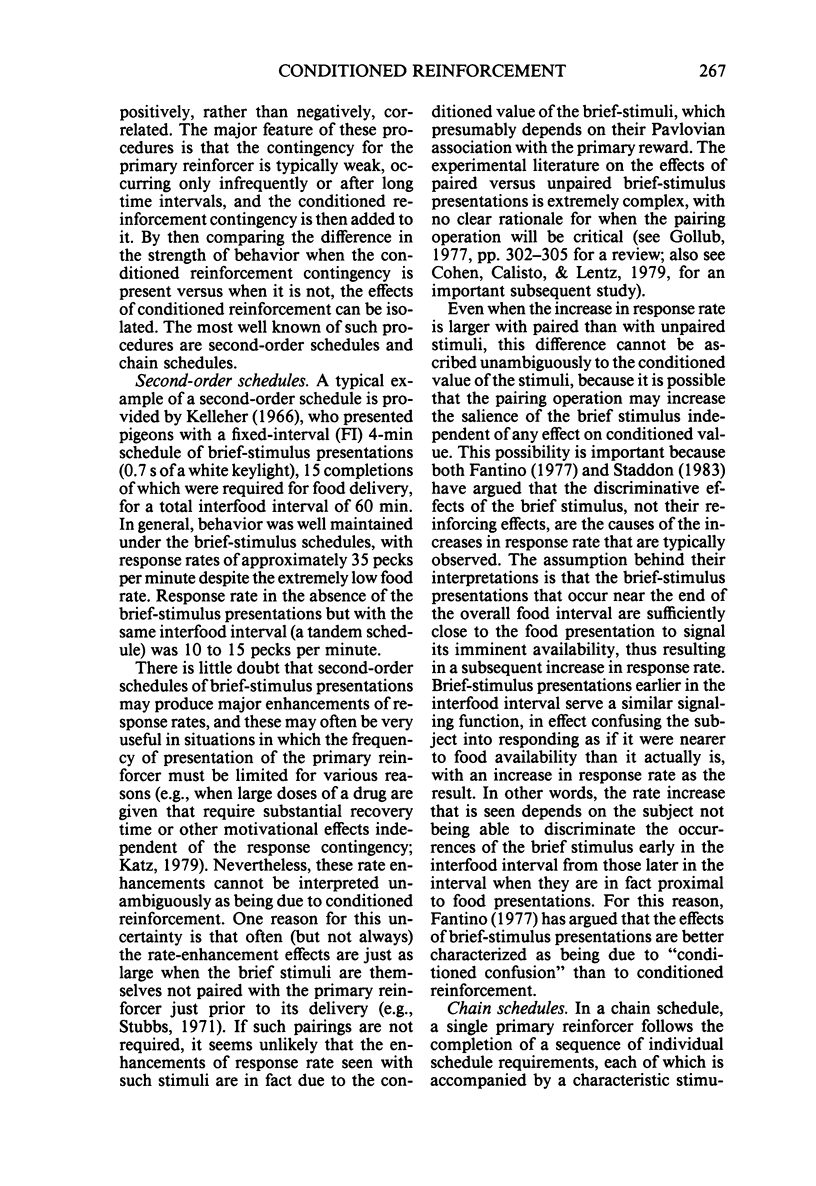
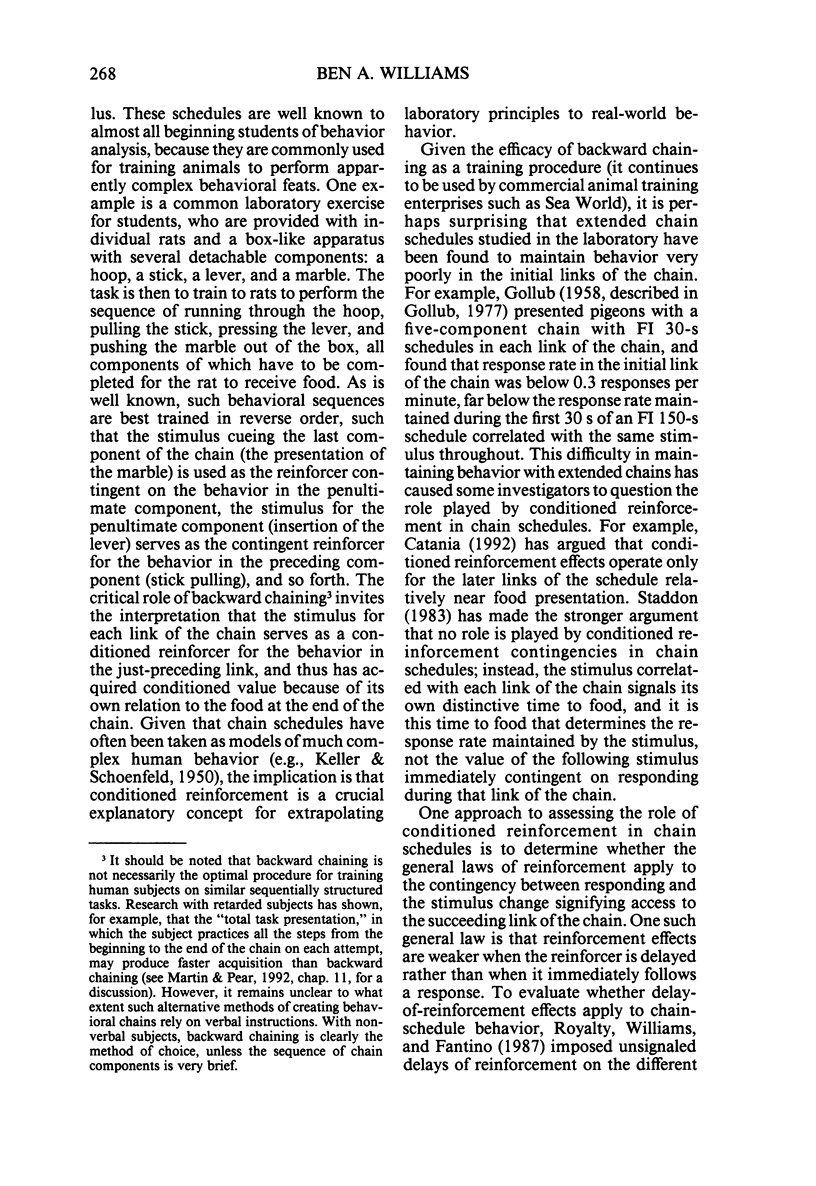

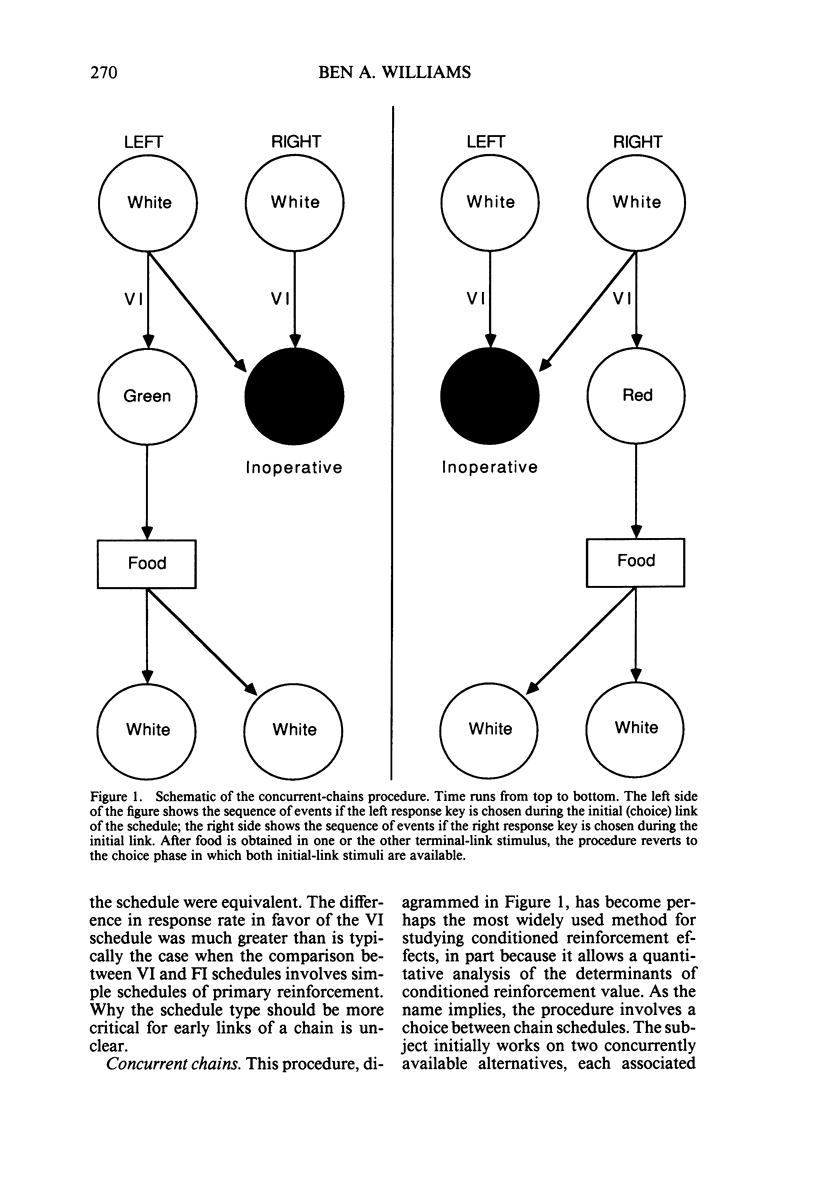
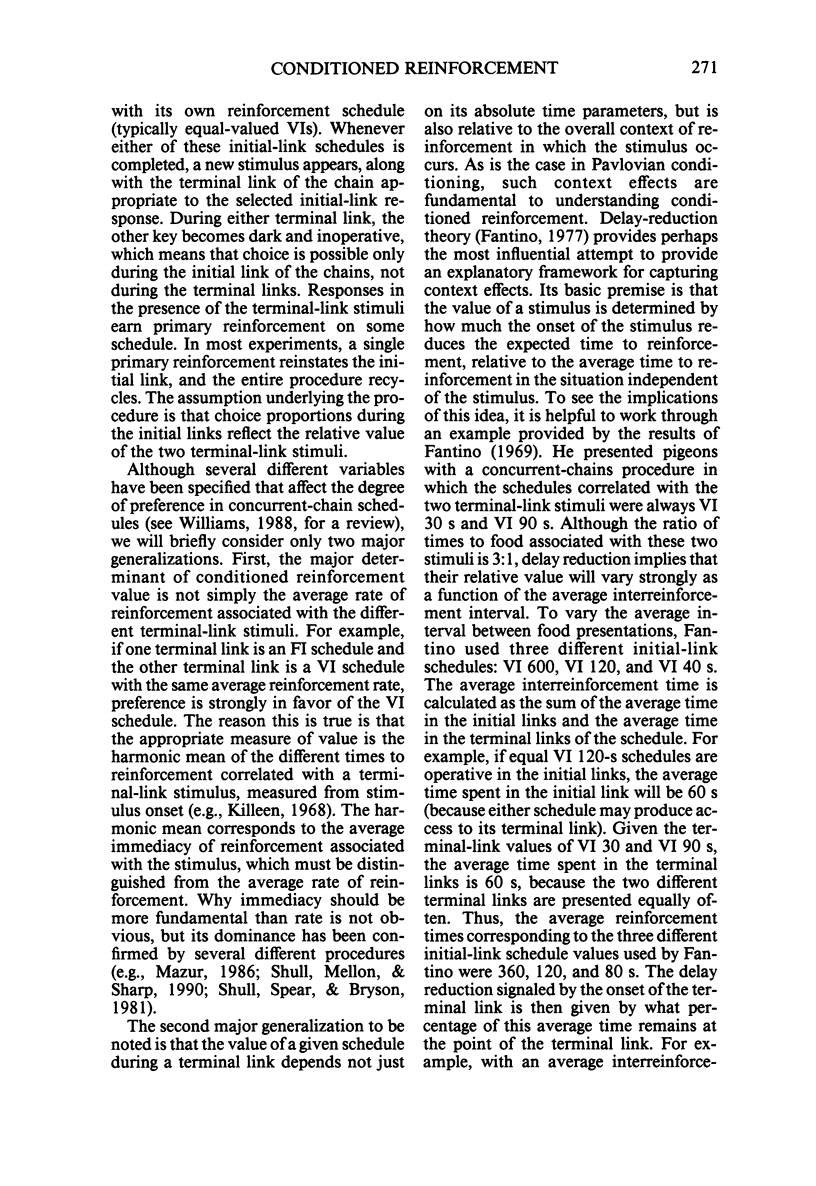
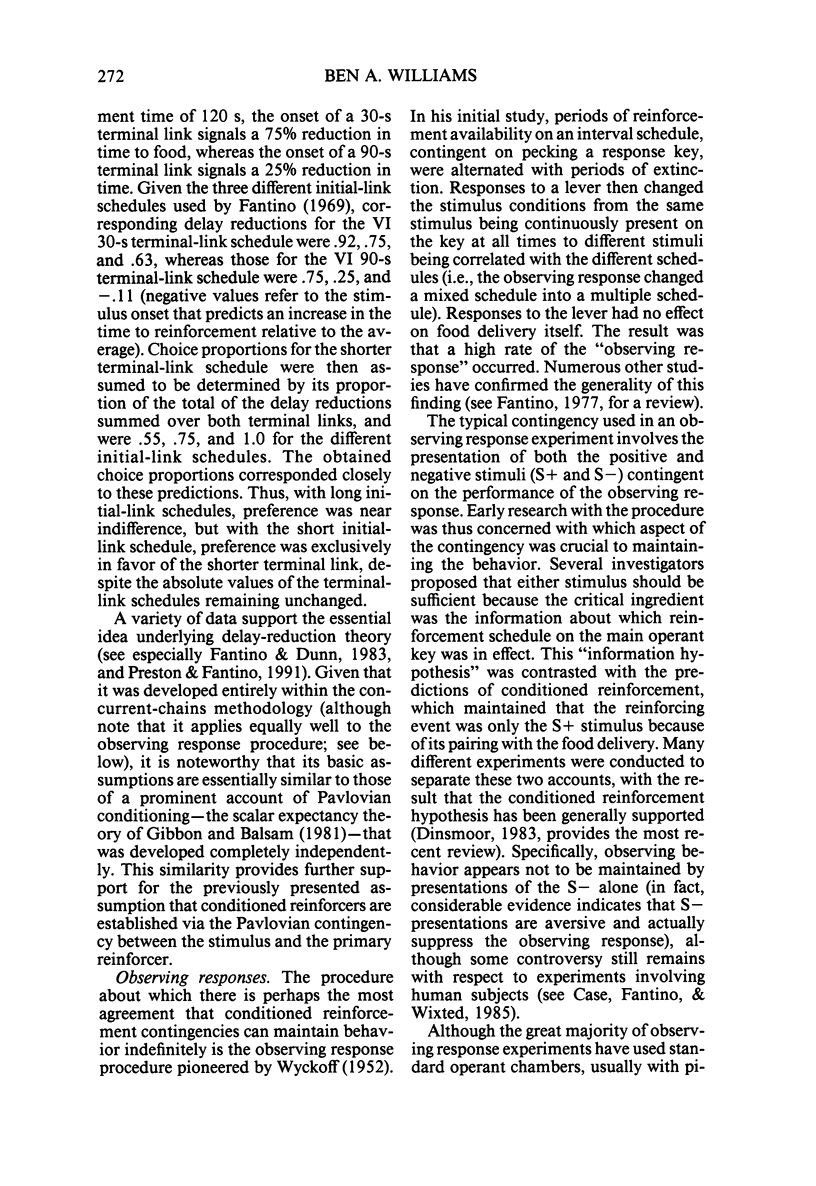
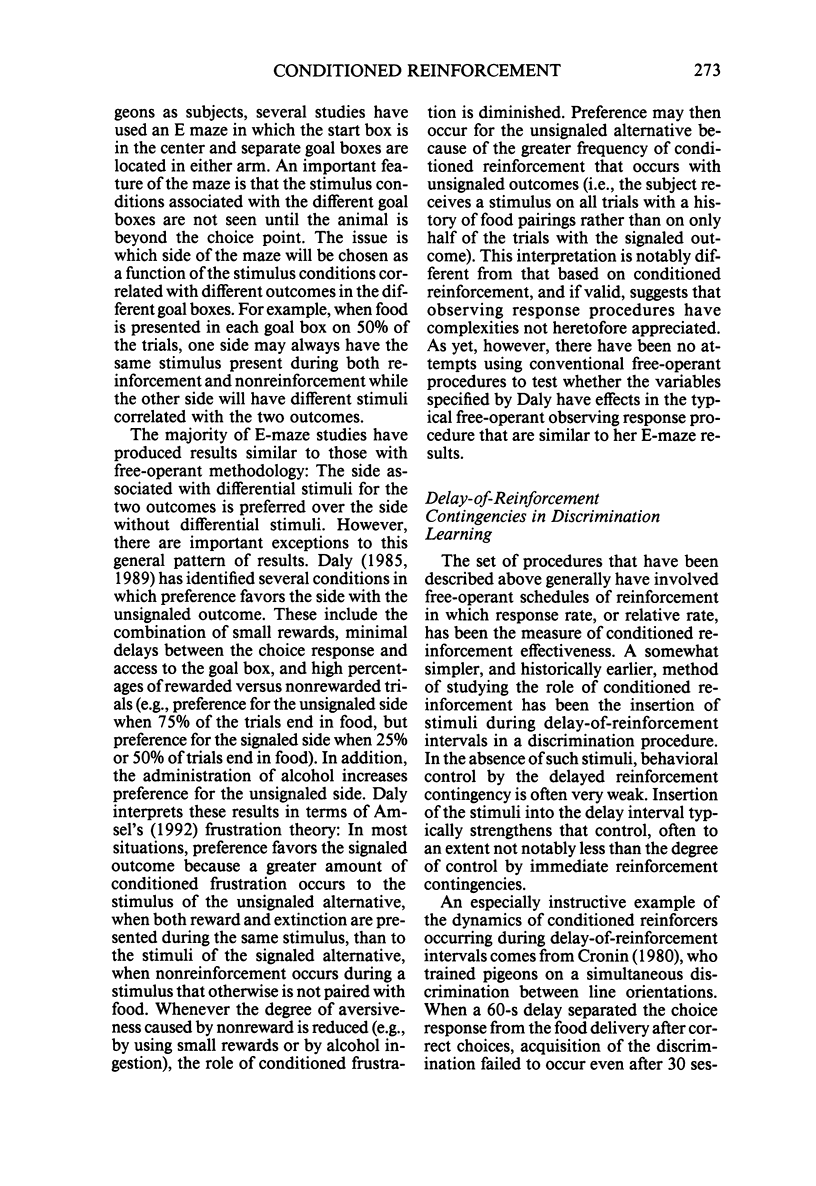
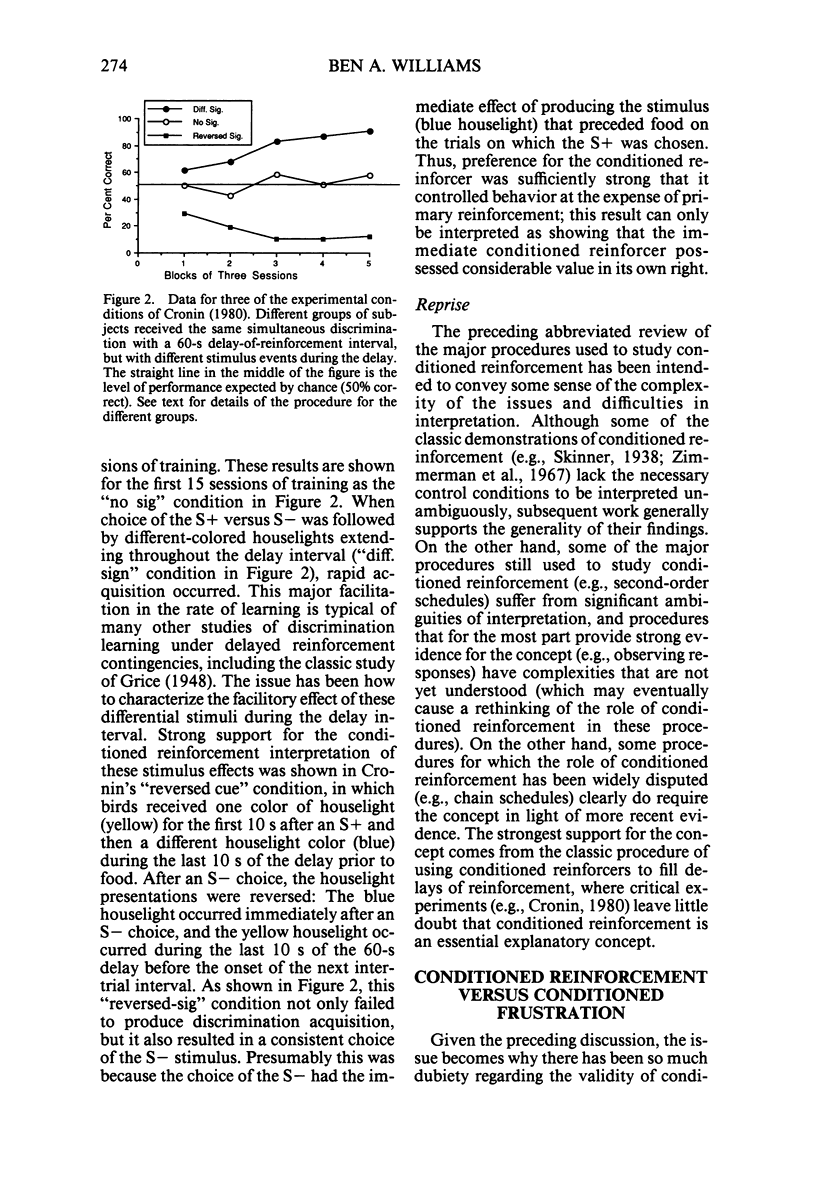
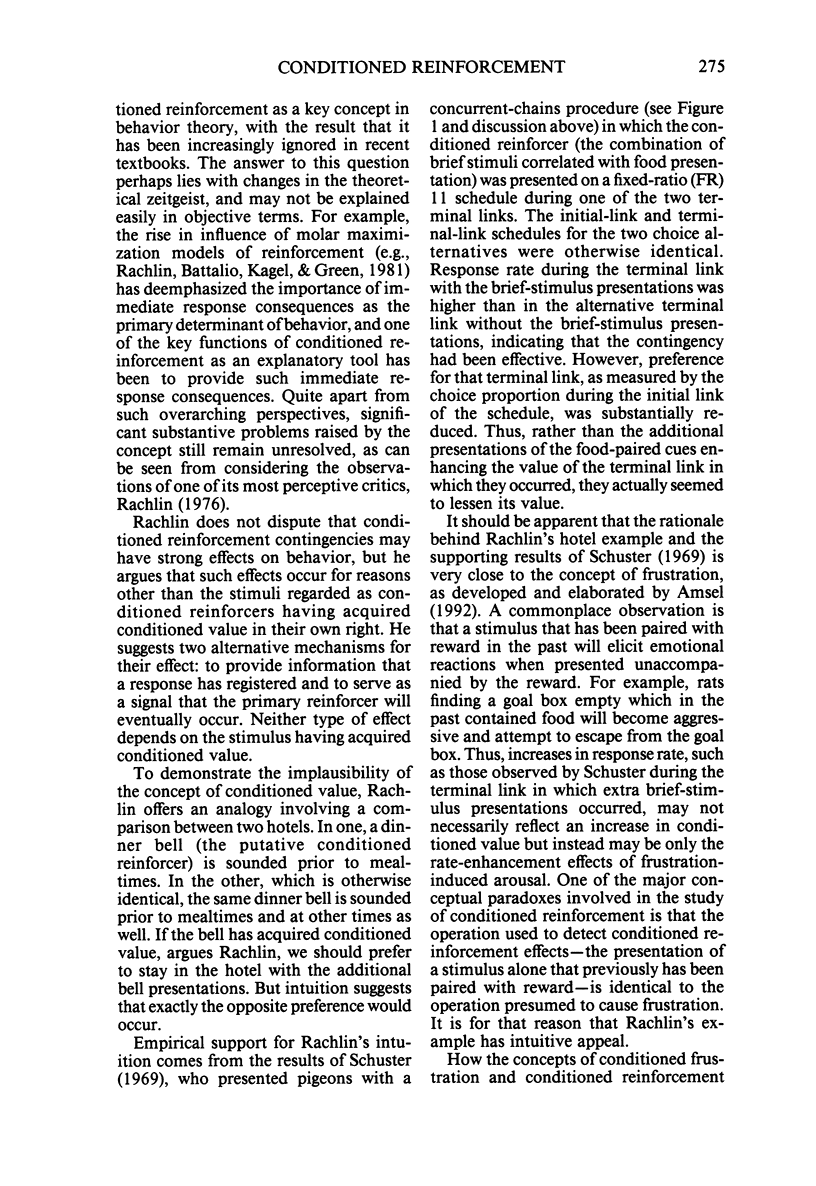
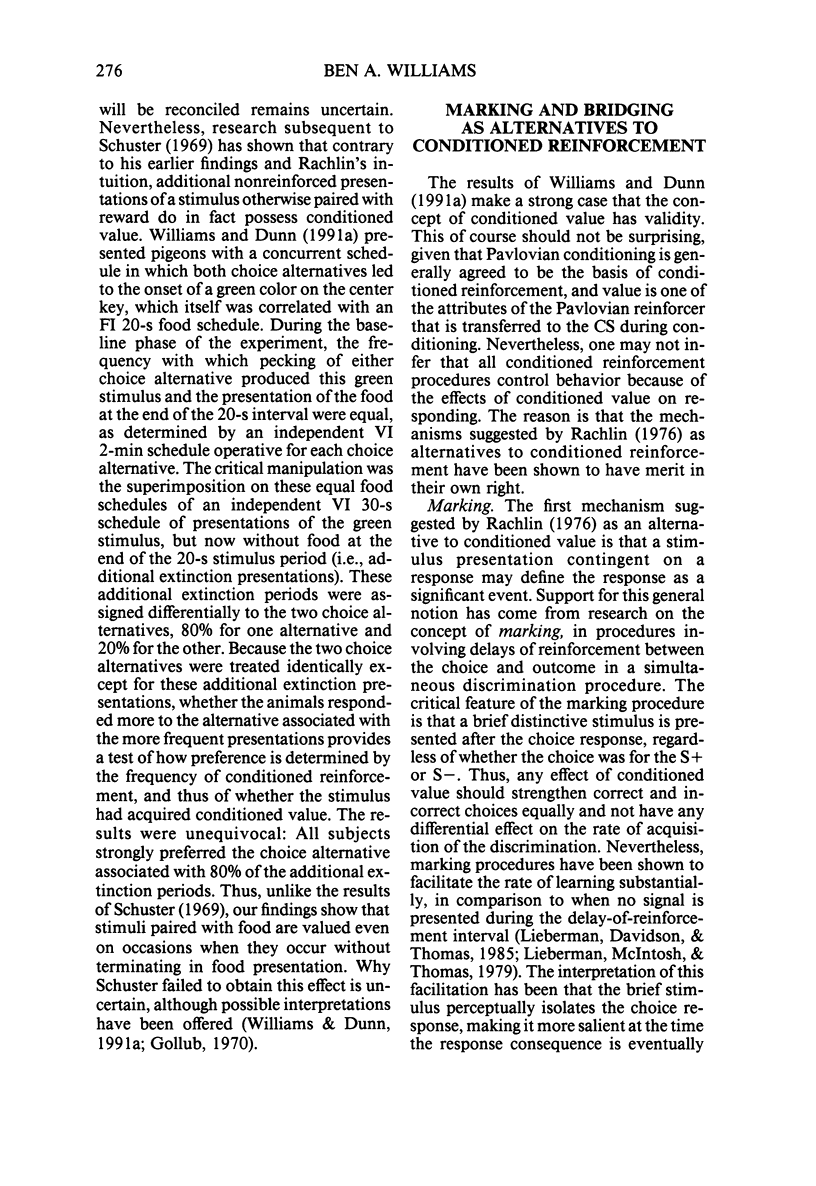
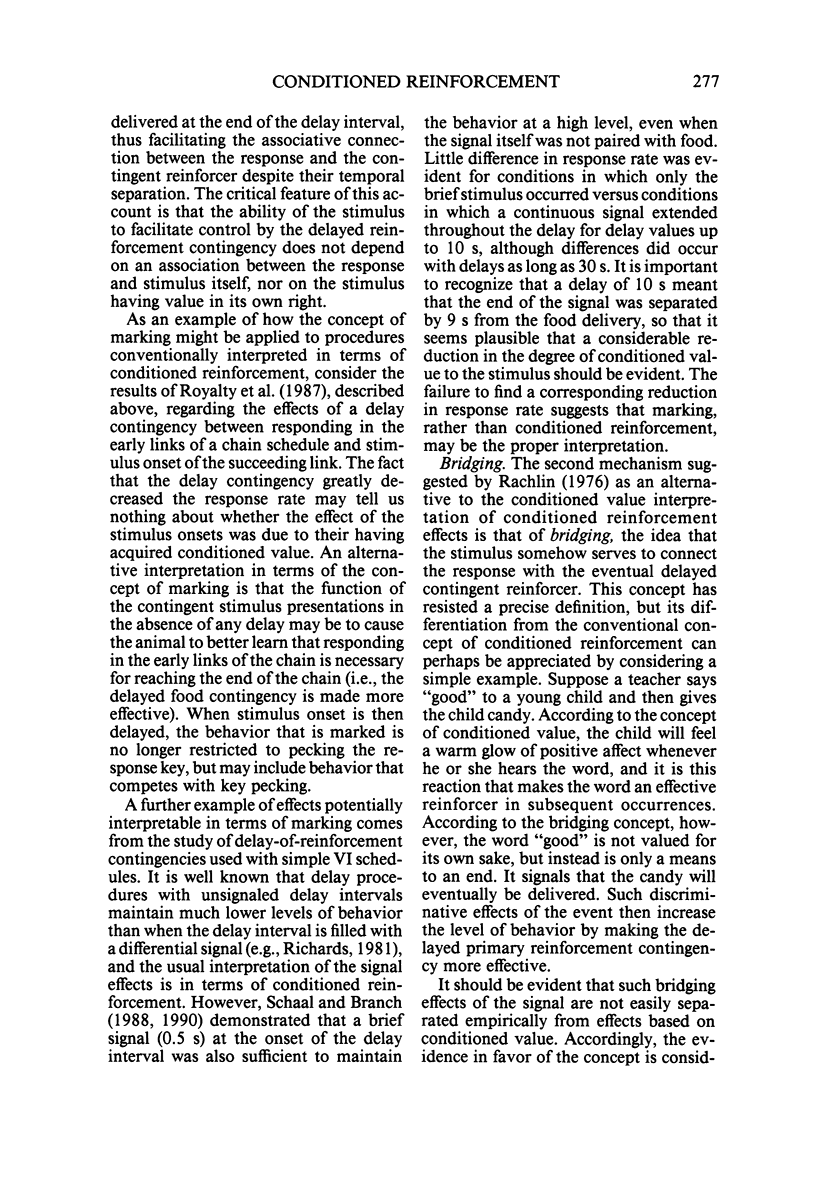
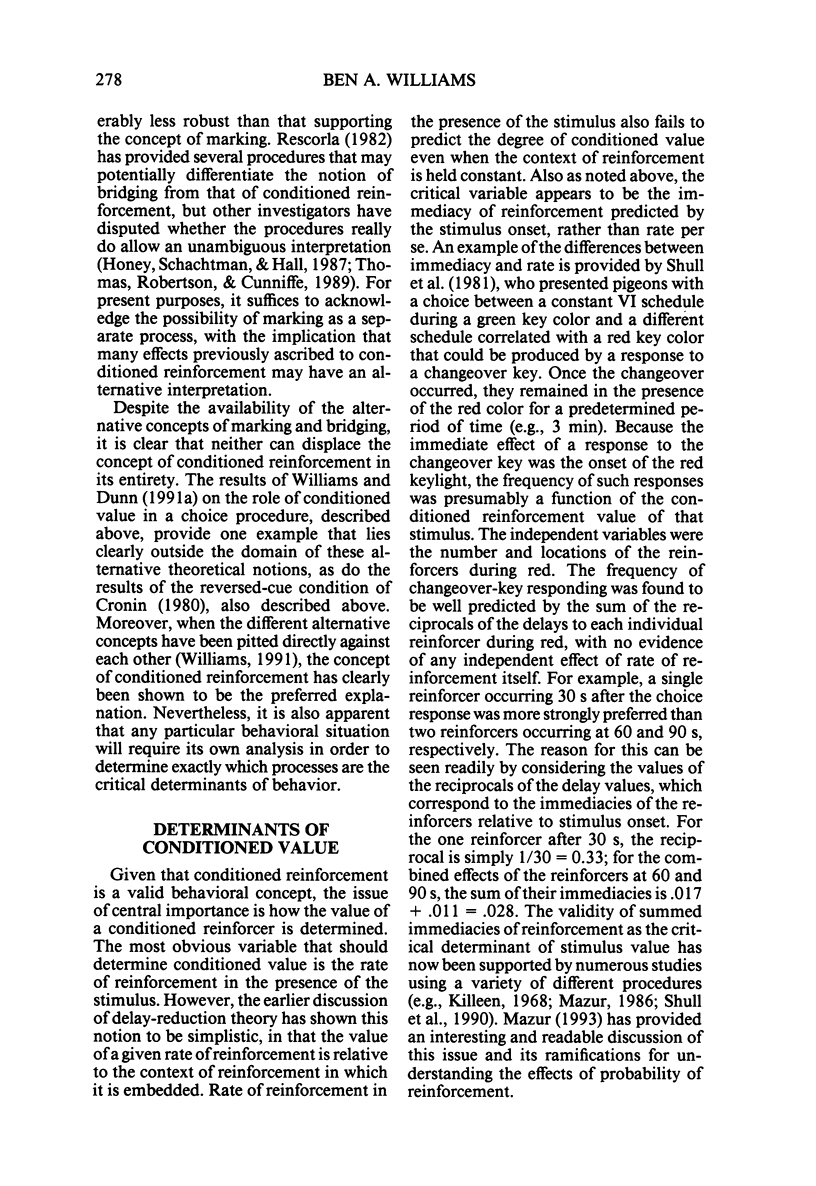
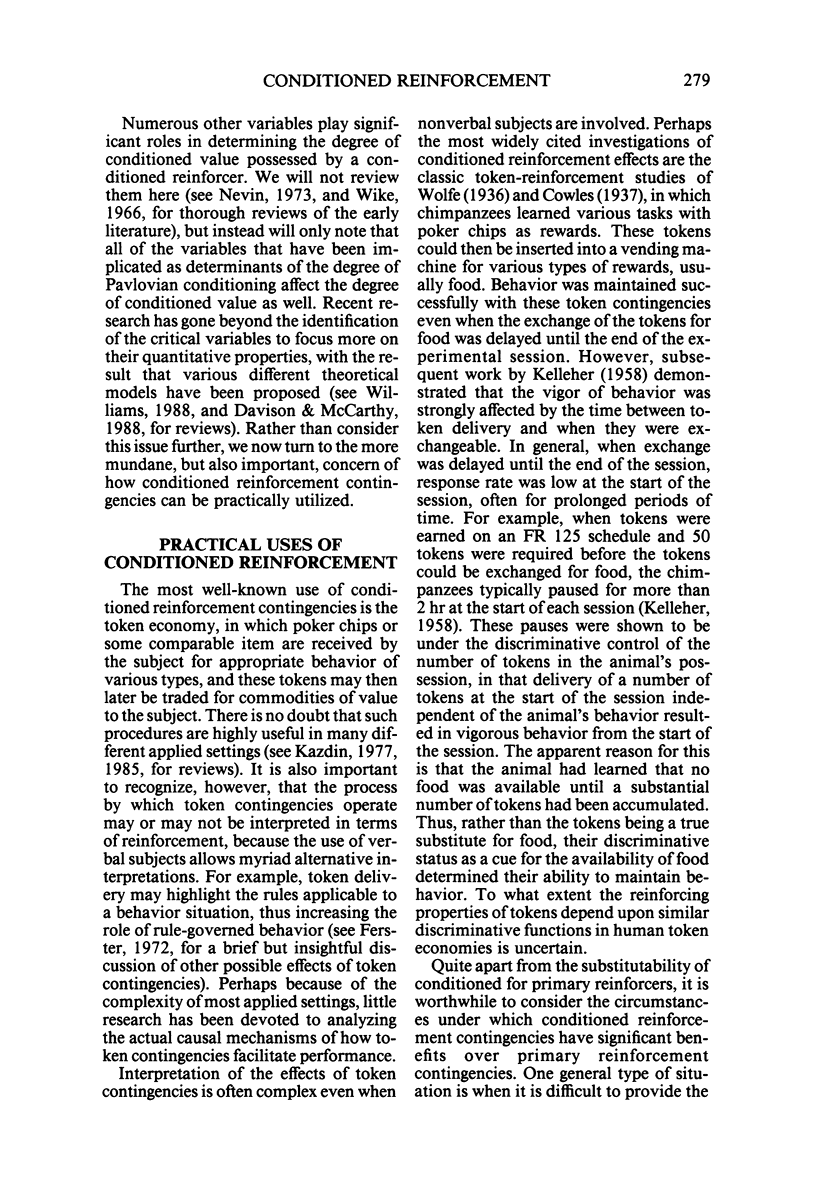
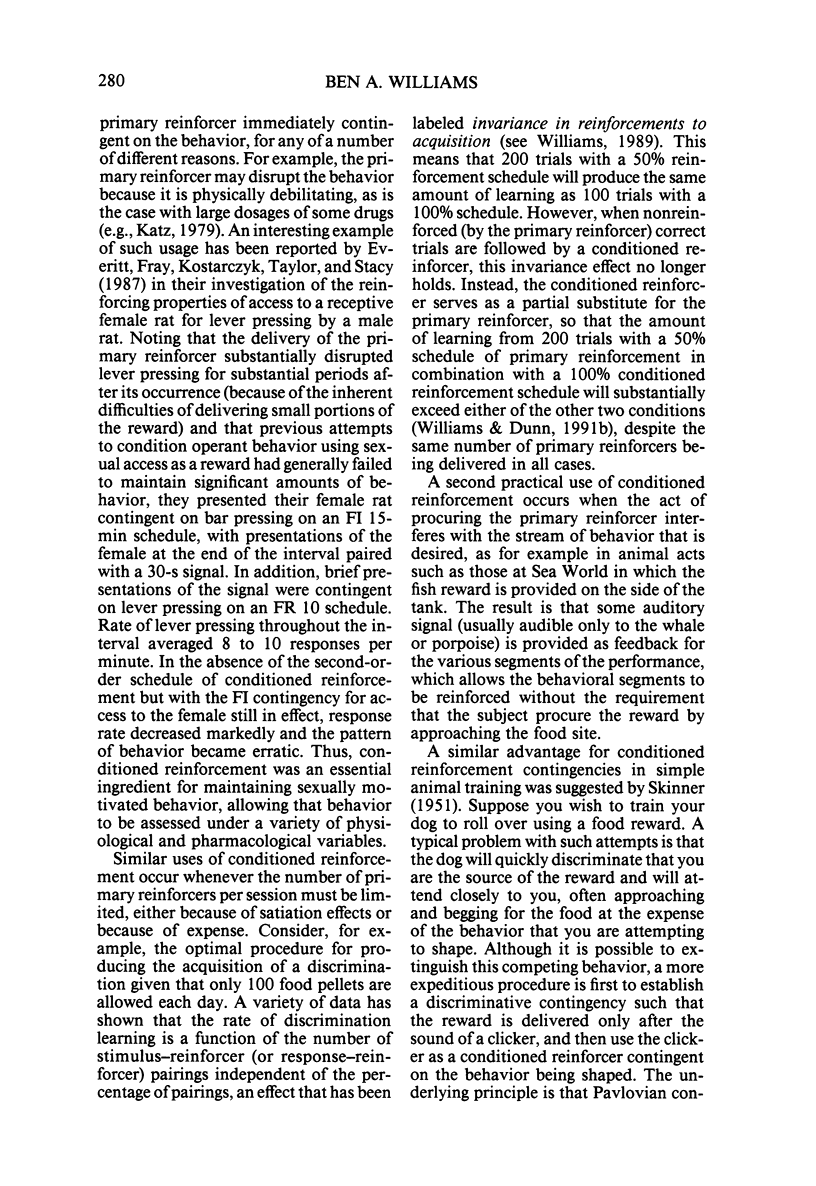
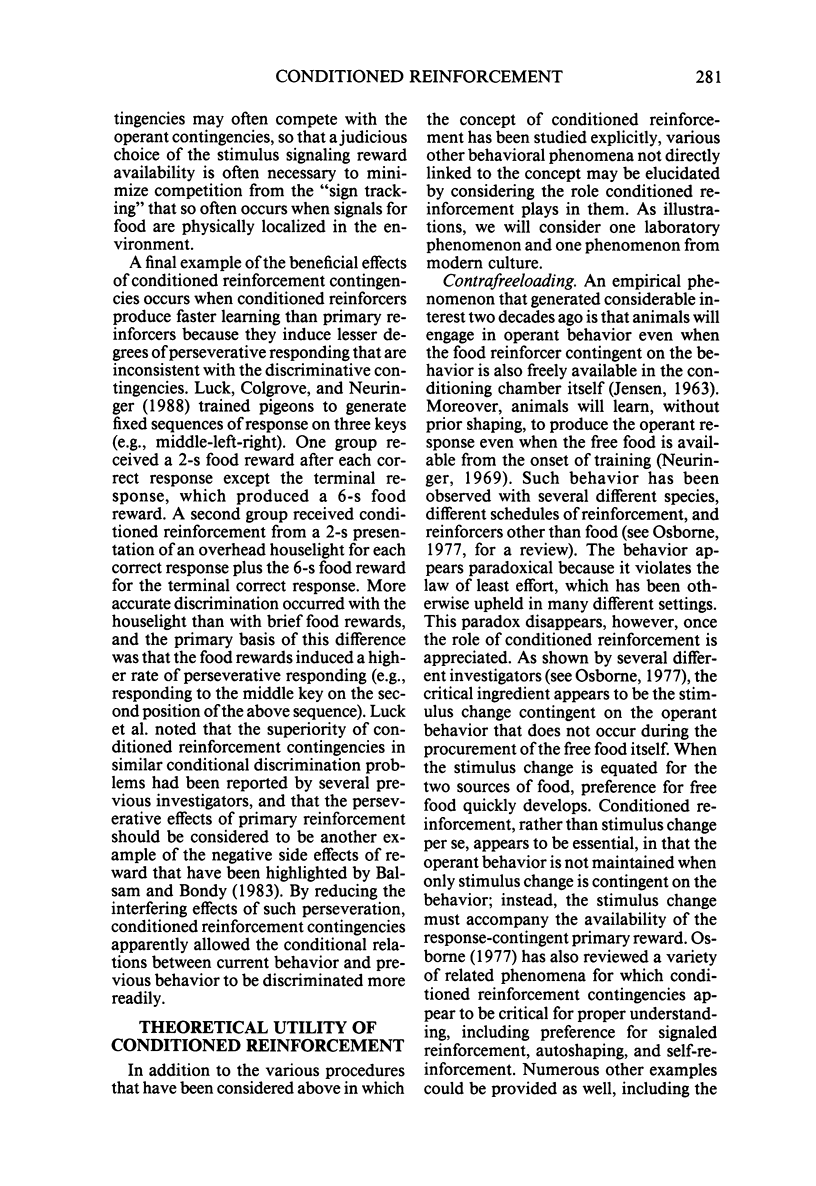
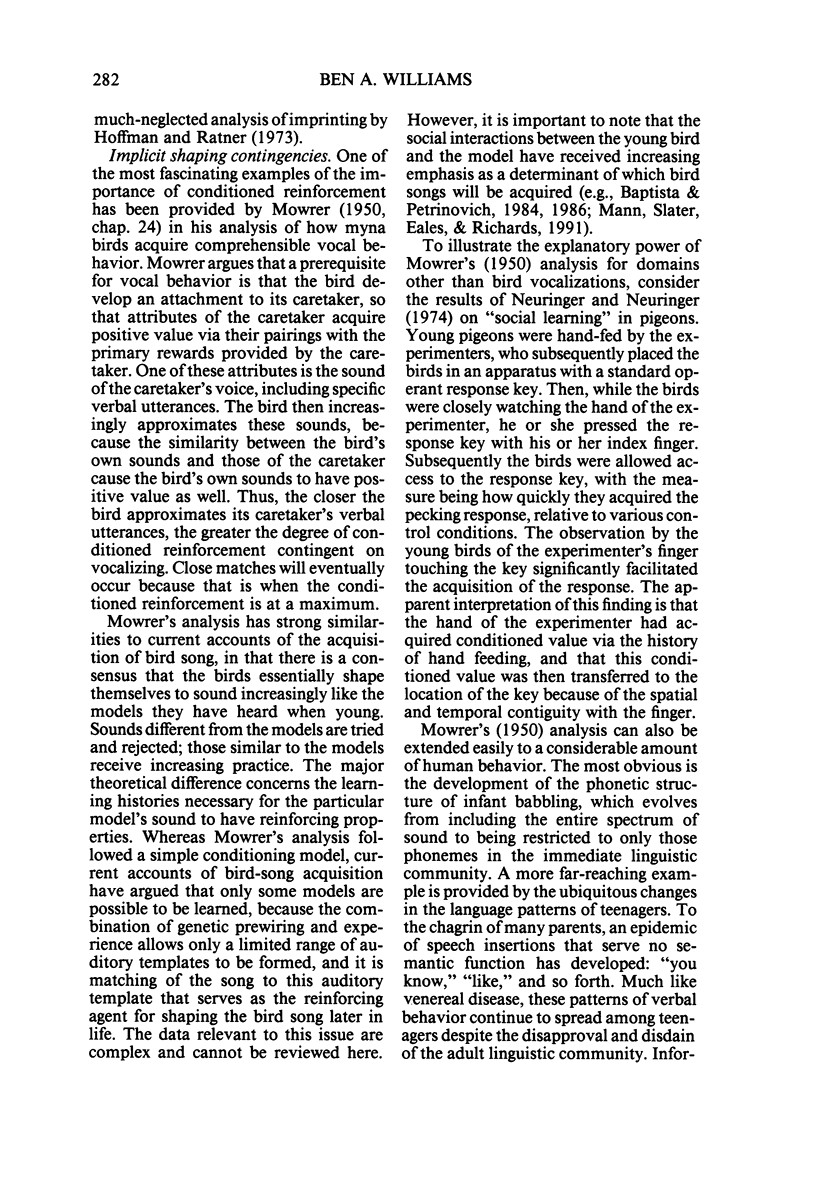
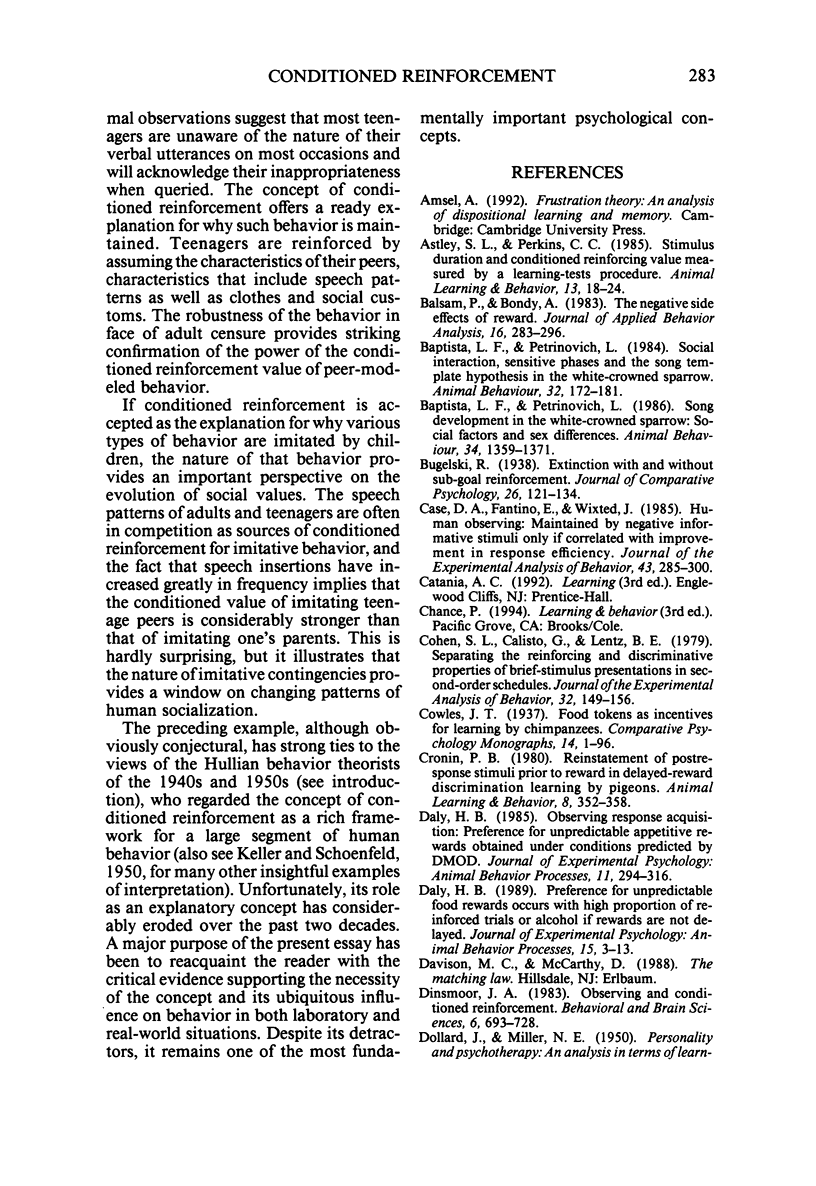
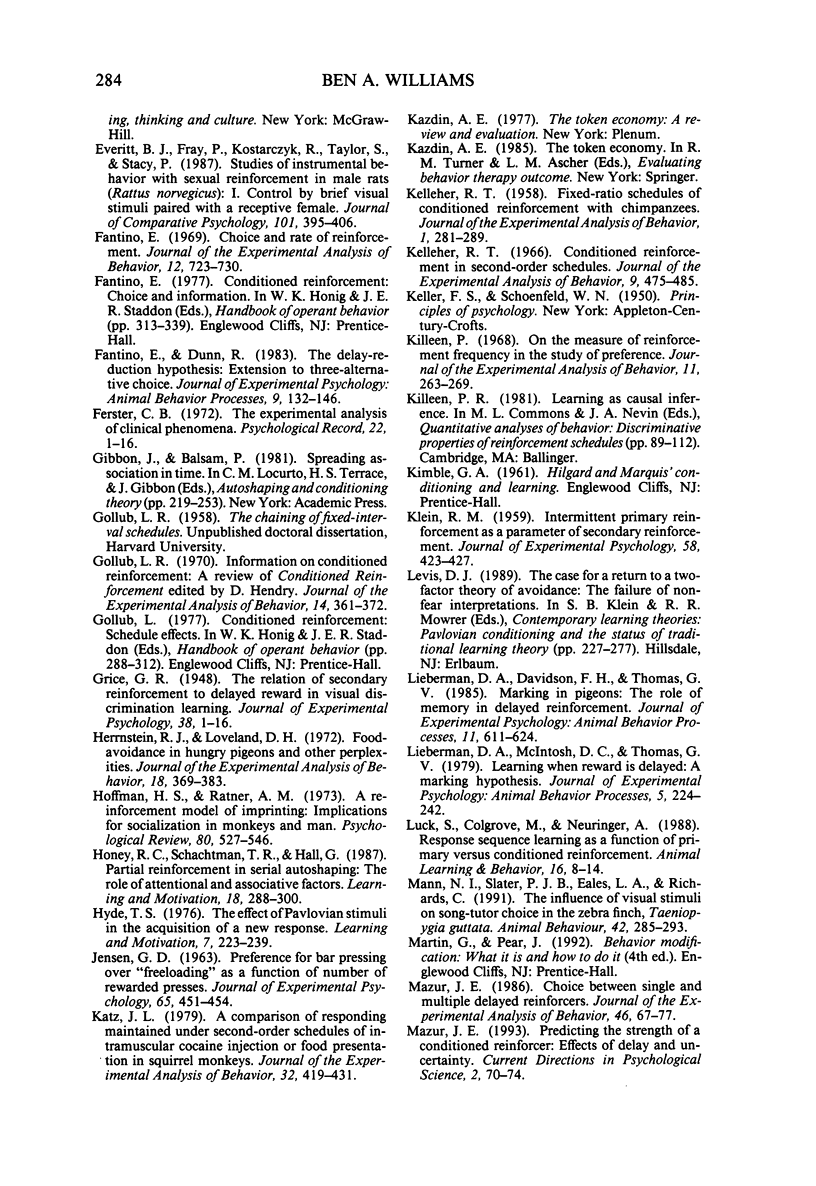
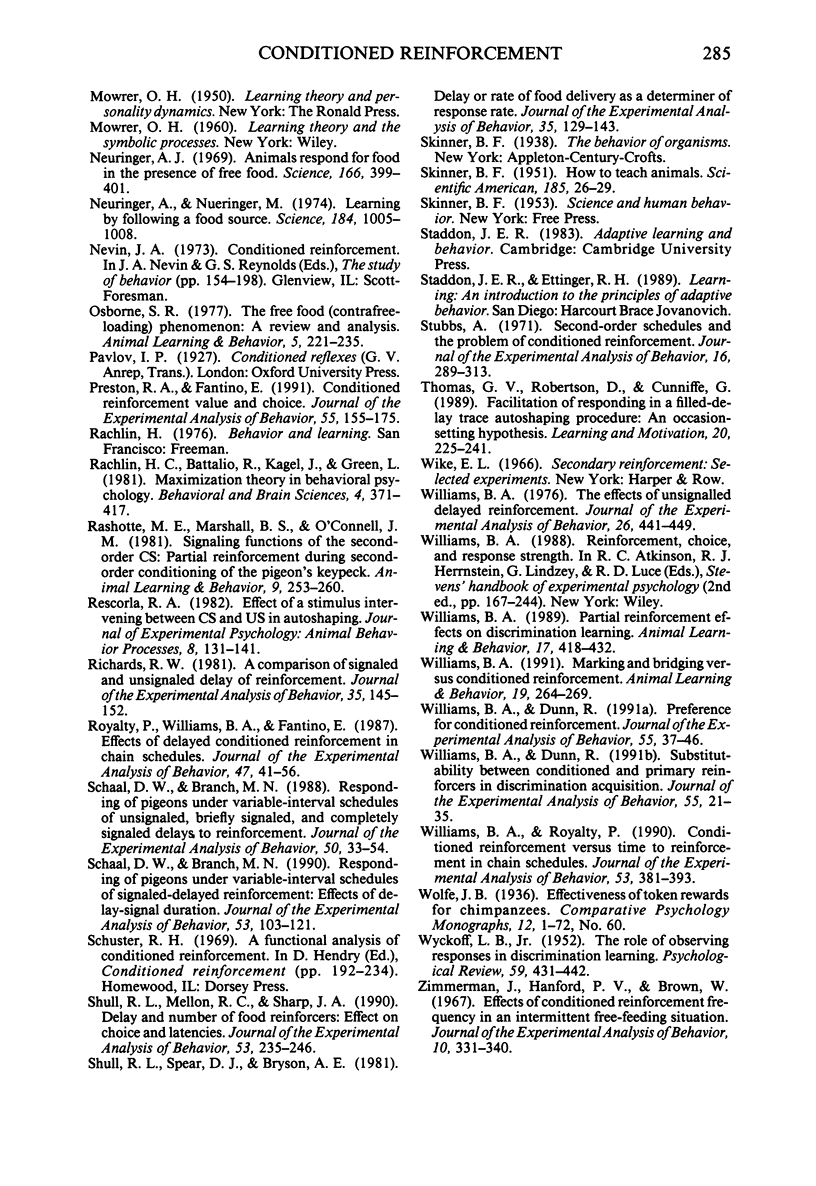
Selected References
These references are in PubMed. This may not be the complete list of references from this article.
- Balsam P. D., Bondy A. S. The negative side effects of reward. J Appl Behav Anal. 1983 Fall;16(3):283–296. doi: 10.1901/jaba.1983.16-283. [DOI] [PMC free article] [PubMed] [Google Scholar]
- Case D. A., Fantino E., Wixted J. Human observing: maintained by negative informative stimuli only if correlated with improvement in response efficiency. J Exp Anal Behav. 1985 May;43(3):289–300. doi: 10.1901/jeab.1985.43-289. [DOI] [PMC free article] [PubMed] [Google Scholar]
- Cohen S. L., Calisto G., Lentz B. E. Separating the reinforcing and discriminative properties of brief-stimulus presentations in second-order schedules. J Exp Anal Behav. 1979 Sep;32(2):149–156. doi: 10.1901/jeab.1979.32-149. [DOI] [PMC free article] [PubMed] [Google Scholar]
- Daly H. B. Observing response acquisition: preference for unpredictable appetitive rewards obtained under conditions predicted by DMOD. J Exp Psychol Anim Behav Process. 1985 Apr;11(2):294–316. doi: 10.1037//0097-7403.11.2.294. [DOI] [PubMed] [Google Scholar]
- Daly H. B. Preference for unpredictable food rewards occurs with high proportion of reinforced trials or alcohol if rewards are not delayed. J Exp Psychol Anim Behav Process. 1989 Jan;15(1):3–13. [PubMed] [Google Scholar]
- Everitt B. J., Fray P., Kostarczyk E., Taylor S., Stacey P. Studies of instrumental behavior with sexual reinforcement in male rats (Rattus norvegicus): I. Control by brief visual stimuli paired with a receptive female. J Comp Psychol. 1987 Dec;101(4):395–406. [PubMed] [Google Scholar]
- Fantino E. Choice and rate of reinforcement. J Exp Anal Behav. 1969 Sep;12(5):723–730. doi: 10.1901/jeab.1969.12-723. [DOI] [PMC free article] [PubMed] [Google Scholar]
- GRICE G. R. The relation of secondary reinforcement to delayed reward in visual discrimination learning. J Exp Psychol. 1948 Feb;38(1):1–16. doi: 10.1037/h0061016. [DOI] [PubMed] [Google Scholar]
- Herrnstein R. J., Loveland D. H. Food-avoidance in hungry pigeons, and other perplexities. J Exp Anal Behav. 1972 Nov;18(3):369–383. doi: 10.1901/jeab.1972.18-369. [DOI] [PMC free article] [PubMed] [Google Scholar]
- KLEIN R. M. Intermittent primary reinforcement as a parameter of secondary reinforcement. J Exp Psychol. 1959 Dec;58:423–427. doi: 10.1037/h0047692. [DOI] [PubMed] [Google Scholar]
- Katz J. L. A comparison of responding maintained under second-order schedules of intramuscular cocaine injection or food presentation in squirrel monkeys. J Exp Anal Behav. 1979 Nov;32(3):419–431. doi: 10.1901/jeab.1979.32-419. [DOI] [PMC free article] [PubMed] [Google Scholar]
- Kelleher R. T. Conditioned reinforcement in second-order schedules. J Exp Anal Behav. 1966 Sep;9(5):475–485. doi: 10.1901/jeab.1966.9-475. [DOI] [PMC free article] [PubMed] [Google Scholar]
- Kelleher R. T. Fixed-ratio schedules of conditioned reinforcement with chimpanzees. J Exp Anal Behav. 1958 Aug;1(3):281–289. doi: 10.1901/jeab.1958.1-281. [DOI] [PMC free article] [PubMed] [Google Scholar]
- Killeen P. On the measurement of reinforcement frequency in the study of preference. J Exp Anal Behav. 1968 May;11(3):263–269. doi: 10.1901/jeab.1968.11-263. [DOI] [PMC free article] [PubMed] [Google Scholar]
- Lieberman D. A., McIntosh D. C., Thomas G. V. Learning when reward is delayed: a marking hypothesis. J Exp Psychol Anim Behav Process. 1979 Jul;5(3):224–242. doi: 10.1037//0097-7403.5.3.224. [DOI] [PubMed] [Google Scholar]
- Mazur J. E. Choice between single and multiple delayed reinforcers. J Exp Anal Behav. 1986 Jul;46(1):67–77. doi: 10.1901/jeab.1986.46-67. [DOI] [PMC free article] [PubMed] [Google Scholar]
- Neuringer A. J. Animals respond for food in the presence of free food. Science. 1969 Oct 17;166(3903):399–401. doi: 10.1126/science.166.3903.399. [DOI] [PubMed] [Google Scholar]
- Neuringer A., Neuringer M. Learning by following a food source. Science. 1974 May 31;184(4140):1005–1008. doi: 10.1126/science.184.4140.1005. [DOI] [PubMed] [Google Scholar]
- doi: 10.1901/jeab.1970.14-361. [DOI] [PMC free article] [Google Scholar]
- Preston R. A., Fantino E. Conditioned reinforcement value and choice. J Exp Anal Behav. 1991 Mar;55(2):155–175. doi: 10.1901/jeab.1991.55-155. [DOI] [PMC free article] [PubMed] [Google Scholar]
- Rescorla R. A. Effect of a stimulus intervening between CS and US in autoshaping. J Exp Psychol Anim Behav Process. 1982 Apr;8(2):131–141. [PubMed] [Google Scholar]
- Richards R. W. A comparison of signaled and unsignaled delay of reinforcement. J Exp Anal Behav. 1981 Mar;35(2):145–152. doi: 10.1901/jeab.1981.35-145. [DOI] [PMC free article] [PubMed] [Google Scholar]
- Royalty P., Williams B. A., Fantino E. Effects of delayed conditioned reinforcement in chain schedules. J Exp Anal Behav. 1987 Jan;47(1):41–56. doi: 10.1901/jeab.1987.47-41. [DOI] [PMC free article] [PubMed] [Google Scholar]
- Schaal D. W., Branch M. N. Responding of pigeons under variable-interval schedules of signaled-delayed reinforcement: effects of delay-signal duration. J Exp Anal Behav. 1990 Jan;53(1):103–121. doi: 10.1901/jeab.1990.53-103. [DOI] [PMC free article] [PubMed] [Google Scholar]
- Schaal D. W., Branch M. N. Responding of pigeons under variable-interval schedules of unsignaled, briefly signaled, and completely signaled delays to reinforcement. J Exp Anal Behav. 1988 Jul;50(1):33–54. doi: 10.1901/jeab.1988.50-33. [DOI] [PMC free article] [PubMed] [Google Scholar]
- Shull R. L., Mellon R. C., Sharp J. A. Delay and number of food reinforcers: Effects on choice and latencies. J Exp Anal Behav. 1990 Mar;53(2):235–246. doi: 10.1901/jeab.1990.53-235. [DOI] [PMC free article] [PubMed] [Google Scholar]
- Shull R. L., Spear D. J., Bryson A. E. Delay or rate of food delivery as determiners of response rate. J Exp Anal Behav. 1981 Mar;35(2):129–143. doi: 10.1901/jeab.1981.35-129. [DOI] [PMC free article] [PubMed] [Google Scholar]
- Stubbs D. A. Second-order schedules and the problem of conditioned reinforcement. J Exp Anal Behav. 1971 Nov;16(3):289–313. doi: 10.1901/jeab.1971.16-289. [DOI] [PMC free article] [PubMed] [Google Scholar]
- WYCKOFF L. B., Jr The role of observing responses in discrimination learning. Psychol Rev. 1952 Nov;59(6):431–442. doi: 10.1037/h0053932. [DOI] [PubMed] [Google Scholar]
- Williams B. A., Royalty P. Conditioned reinforcement versus time to reinforcement in chain schedules. J Exp Anal Behav. 1990 May;53(3):381–393. doi: 10.1901/jeab.1990.53-381. [DOI] [PMC free article] [PubMed] [Google Scholar]
- Williams B. A. The effects of unsignalled delayed reinforcement. J Exp Anal Behav. 1976 Nov;26(3):441–449. doi: 10.1901/jeab.1976.26-441. [DOI] [PMC free article] [PubMed] [Google Scholar]
- Zimmerman J., Hanford P. V., Brown W. Effects of conditioned reinforcement frequency in an intermittent free-feeding situation. J Exp Anal Behav. 1967 Jul;10(4):331–340. doi: 10.1901/jeab.1967.10-331. [DOI] [PMC free article] [PubMed] [Google Scholar]


